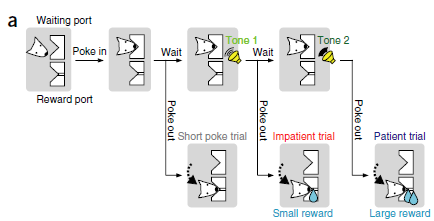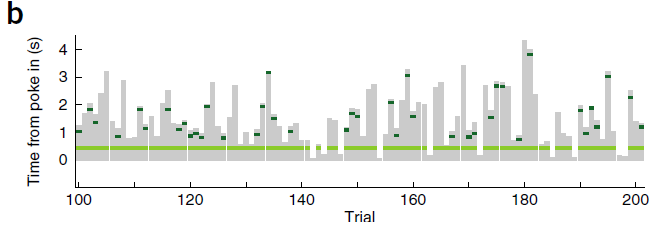If you're interested in how the basal ganglia contribute to motivated actions, it's useful to ask how the basal ganglia communicate with the frontal cortex, and how the frontal cortex contributes to action initiation. Later we can consider how the basal ganglia and cortex together choose actions that have successfully led to rewards in the past.
How does the cortex select actions?
Let's start with Murakami et al. 2004. You'll notice numbers in the margins which correspond to explanations or comments I make below.
- Murakami et al. (2014). Neural antecedents of self-initiated actions in secondary motor cortex. Nat Neurosci, 17(11), 1574-1582. doi: 10.1038/nn.3826
In earlier experiments, researchers discovered a way to predict the moment when an animal was about to initiate an action. They would present the animal with a cue, say a tone, which signaled to the animal that it could receive a reward if it performs a particular behavior - say pressing a lever. The animal soon learned to initiate the behavior when the cue came on. Experimenters noticed that many neurons in the frontal and parietal lobes would respond to the cue, and then those same neurons would start to fire faster and faster -- that is, their firing rates would 'ramp-up'. (See (1) in PDF).
So, for instance, if a particular ramping neuron had a rate of, say, 5 spikes per second, it would ramp-up to some threshold level, say 30 spikes/sec. When the neuron reached that threshold firing rate, the animal would initiate the behavior. Different ramping neurons had different 'threshold' firing rates. But whatever that threshold was for a given neuron, the neuron would nearly always generate the behavior when that threshold firing rate was met.
In this Murakami et al. 2014 experiment, in orer to receive reward, rats had to move their snout into a hole in the wall ('poke in' the waiting port) and wait there until a tone signaled that they can remove the snout ('poke out') to collect a small reward. However, if they remained in the waiting port until a second tone sound came on, they would receive a large reward. Here's figure 1A from their paper, depicting the task:


Just to be clear about the graph, notice that on the next trial, it waited longer (over 1.5 seconds) but in this case it wasn't long enough for the 2nd tone (no dark green triangle on this trial)-- the rat apparently didn't have the patience to wait any longer. So it received onlhy the small reward.
While rats engaged in this task, the experimenters recorded from neurons in cortical area M2 -- a 'premotor' area of the cortex where neurons are known to show activity well before a particular action is initiated - presumably when the animal is 'planning' to carry out a particular action. Take a look at the results on your own. (More commentary to come.) Here's another particularly good study on action, choice, and the cerebral cortex.- Yang et al. (2016). Origins of choice-related activity in mouse somatosensory cortex. Nat Neurosci, 19(1), 127-134. doi: 10.1038/nn.4183
According to some models, the basal ganglia teach the cortex how to enter states that produce actions that lead to rewards:
- Koralek, A. C., Jin, X., Long Ii, J. D., Costa, R. M., & Carmena, J. M. (2012). Corticostriatal plasticity is necessary for learning intentional neuroprosthetic skills. Nature, 483, 331. doi: 10.1038/nature10845
What are neuronal ensembles/assemblies?
- Tsodyks et al. (1999). Linking spontaneous activity of single cortical neurons and the underlying functional architecture. Science, 286(5446), 1943-1946. doi: 10.1126/science.286.5446.1943
- Yuste (2015). From the neuron doctrine to neural networks. Nat Rev Neurosci, 16(8), 487-497. doi: 10.1038/nrn3962
What do the basal ganglia do?
- Shipp, S. (2017). The functional logic of corticostriatal connections. Brain Structure & Function, 222(2), 669-706. doi: 10.1007/s00429-016-1250-9
What are computational approaches to reinforcement?
- Sutton, M. A., & Barto, A. G. (1998). Reinforcement Learning: An Introduction: MIT Press.

